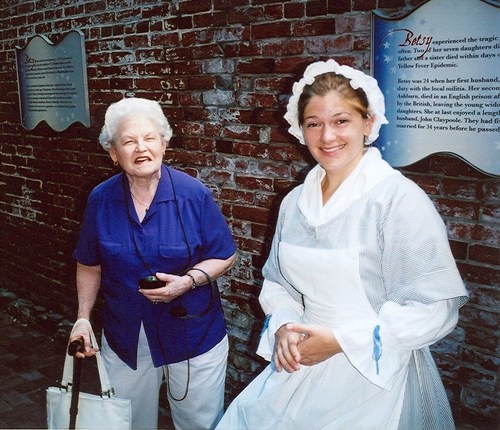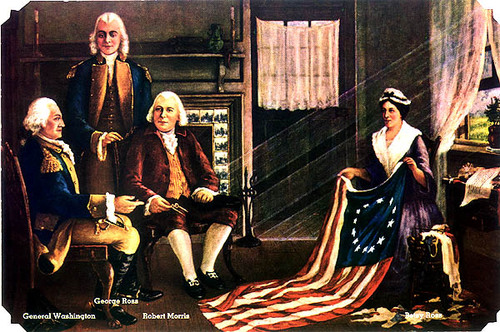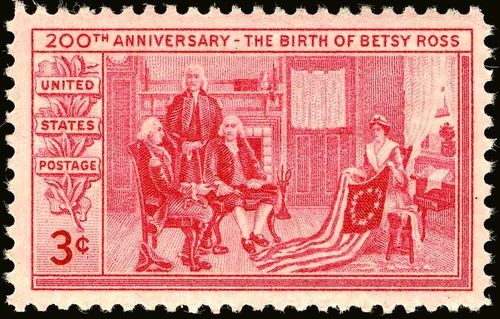Anniversary of our American Flag
LINTON Chronicles
Linton Family Facts and Family Traditional Lore
Brief Historical Sketches
Anniversary of our American Flag
Terry Louis Linton © 2011
Linton Research Fund Inc., Publication © 2011
LINTON & BIRD Chronicles, Volume VI, Issue 3, Fall © 2011, ISSN 1941-3521
updated March 19, 2023
The year 2023 is the 246th Anniversary of our American flag. On June 14, 1777, the Continental Congress, seeking to promote national pride and unity, adopted the national flag. "Resolved: that the flag of the United States be thirteen stripes, alternate red and white; that the union be thirteen stars, white in a blue field, representing a new constellation." Elizabeth "Betsy" Phoebe GRISCOM Ross (1751-1836) was asked to stitch the first new flag for the Continental Navy. Then later she was asked to stitch the new flag for the New Republic.
Evelyn Virginia BIRD Linton (1922-2012) was related to Elizabeth "Betsy" Phoebe GRISCOM through her marriage to John ROSS (1754-1776) the nephew of Mary ROSS (1744-1790) and Colonel George ROSS (1730-1779).
Kirk Louis LINTON (1914-1987) was the 6th cousin five times removed to General George WASHINGTON (1732-1799), through the BALL branch of the LINTON family tree.

Elizabeth “Betsy” Phoebe GRISCOM Ross (1752-1836) Flag

Evelyn Virginia BIRD Linton (1922-2012) talking with her cousin seamstress Betsy Ross (1752-1836) outside of her and her husband, upholster John ROSS (1752-1776) and their upholstery shop located at 89 Arch Street in Philadelphia, Pennsylvania.
The upholster shop was on the ground street level and their residence was the top two floors. The small winding stairs were too much for Mom so she sat and talked with Betsy while I took the 45-minute guided tour. Betsy was a great historical interrater and made a great exception for us and stepped out the back door to have her photo taken with Mom (while I took a photo (they were not alluded inside)
This was one of our (of many long) road trips, this one lasted three weeks covering Isaiah LINTON (1739-1775)’s Jerusalem Mill Village in Hartford County, Maryland. Then on to Philadelphia, Pennsylvania seeing the Betsy Ross upholster shop and home her grave. Betsy told us where they went to church and where her husband was buried.
Next stop, right up the block to Christ Church where John’s father was the assistant rector. We sat in John & Betsy’s pew and visited the graves of her husband, John ROSS (1752-1776). “John enlisted in the Pennsylvania Militia in April 1775, just after the battles of Lexington and Concord. John was guarding militia mutations in Philadelphia leaving Betsy to take full charge of their upholstery shop. John, serving under his uncle Colonel George ROSS (1730-1779), died on Janrs_of_the_Declaration_of_Independence.html">Colonel George ROSS (1730-1779), died on January 21, 1776, from wounds he received from an explosion of gunpowder on the city wharf. John Ross's "broken, bleeding and unconscious form was carried through the snow from the wharf by four militiamen to his shop. He never regained consciousness and was buried at the nearby Episcopalian Christ Church."
John was the nephew of Mary ROSS (1744-1790) who was married to Colonel Mark BIRD (1738-1812) and her brother John’s uncle Colonel George ROSS (1730-1779) who signed the Declaration of Independence for the Colony of Pennsylvania was married to Mary BIRD (1753–1813) the sister of Colonel Mark BIRD (1738-1812).
Painting Below: "The Birth Of Our Nations Flag" by Charles H. Weisgerber; General George Washington (1733-1799), Colonel George Ross (1730-1779), signer of the Declaration of Independence for Pennsylvania Colony, the brother of Mary Ross (1744-1790) and uncle of John Ross (1751-1776) and brother-in-law of Colonel Mark Bird (1739-1812); Robert Morris (1734-1806) signer of the Declaration of Independence for Pennsylvania Colony and Betsy GRISCOM Ross (1751-1836).

Rachel Fletcher Affidavit Dated July 31, 1871
Affidavit of Rachel Fletcher, a daughter of Elizabeth Claypoole (Betsy Ross) “I remember having heard my mother Elizabeth Claypoole say frequently that she, with her own hands, (while she was the widow of John Ross,) made the first Star-spangled Banner that ever was made. I remember to have heard her also say that it was made on the order of a Committee, of whom Col. Ross was one, and that Robert Morris was also one of the Committee. That General Washington, acting in conference with the committee, called with them at her house. This house was on the North side of Arch Street a few doors below Third Street, above Bread Street, a two-story house, with attic and a dormer window, now standing, the only one of the row left, the old number being 89; it was formerly occupied by Daniel Niles, Shoemaker. Mother at first lived in the house next East, and when the war came, she moved into the house of Daniel Niles. That it was in the month of June 1776, or shortly before the Declaration of Independence that the committee called on her. That the member of the committee named Ross was an uncle of her deceased husband. That she was previously well acquainted with Washington, and that he had often been in her house in friendly visits, as well as on business. That she had embroidered ruffles for his shirt bosoms and cuffs, and that it was partly owing to his friendship for her that she was chosen to make the flag. That when the committee (with General Washington) came into her store she showed them into her parlor, back of her store; and one of them asked her if she could make a flag and that she replied that she did not know but she could try. That they then showed her a drawing roughly executed, of the flag as it was proposed to be made by the committee, and that she saw in it some defects in its proportions and the arrangement and shape of the stars. That she said it was square and a flag should be one third longer than its width, that the stars were scattered promiscuously over the field, and she said they should be either in lines or in some adopted form as a circle, or a star, and that the stars were six-pointed in the drawing, and she said they should be five pointed. That the gentlemen of the committee and General Washington very respectfully considered the suggestions and acted upon them, General Washington seating himself at a table with a pencil and paper, altered the drawing and then made a new one according to the suggestions of my mother. That General Washington seemed to her to be the active one in making the design, the others having little or nothing to do with it. That the committee then requested her to call on one of their number, a shipping merchant on the wharf, and then adjourned. That she was punctual to her appointment, and then the gentleman drew out of a chest an old ship's color which he loaned her to show her how the sewing was done; and also gave her the drawing finished according to her suggestions. That this drawing was done in water colors by William Barrett, an artist, who lived on the North side of Cherry Street above Third Street, a large three story brick house on the West side of an alley which ran back to the Pennsylvania Academy for Young Ladies," [note missing open quotation mark, probably meant before "Pennsylvania Academy" --Webmaster] kept by James A. Neal, the best school of the kind in the city at that time. That Barrett only did the painting, and had nothing to do with the design. He was often employed by mother afterwards to paint the coats of arms of the United States and of the States on silk flags. That other designs had also been made by the committee and given to other seamstresses to make, but that they were not approved. That mother went diligently to work upon her flag and soon finished it, and returned it, the first star-spangled banner that ever was made, to her employers, that it was run up to the peak of one of the vessels belonging to one of the committee then lying at the wharf, and was received with shouts of applause by the few bystanders who happened to be looking on. That the committee on the same day carried the flag into the Congress sitting in the State House, and made a report presenting the flag and the drawing and that Congress unanimously approved and accepted the report. That the next day Col. Ross called upon my mother and informed her that her work had been approved and her flag adopted, and he gave orders for the purchase of all the materials and the manufacture of as many flags as she could make. And that from that time forward, for over fifty years she continued to make flags for the United States Government.
I believe the facts stated in the foregoing Article entitled "The First American Flag and Who Made It," are all strictly true. This affidavit having been signed by Rachel Fletcher with violet ink, the signature has faded, but is at this time, Seventh Month 24th, 1908, still plainly legible.
Rachel Fletcher
I, Mary Fletcher Wigert, daughter of the said Rachel Fletcher, recognize the signature in the rectangular space outlined in black above, as the signature of my mother Rachel Fletcher.
This 1952 stamp was given to me in 1956, by my Grandma Linton, Annie Lucretia CRONK (1888-1956) a long with her full stamp collection she had stated as a young girl.


Linton Research Fund Inc., Publication © 1987-2023 "Digging for our Roots"
Main Menu
Linton Research Fund, Inc., HOME PAGE
LINTON Chronicles Table of Contexts
BIRD Chronicles r;">SURNAME Index
Today's Birthdays & Anniversaries
History of the Linton Research Fund Inc., LINTON & BIRD Chronicles
LINTON & BIRD Chronicles on Facebook
![]() "Thanks for Visiting, come back when you can stay longer" Terry Louis Linton © 2007
"Thanks for Visiting, come back when you can stay longer" Terry Louis Linton © 2007
Linton Research Fund Inc., Publication © 1987-2023 “Digging for our roots”
LINTON & BIRD Chronicles
Established 1984
Quarterly Publication of the Linton Research Fund Inc. ![]()